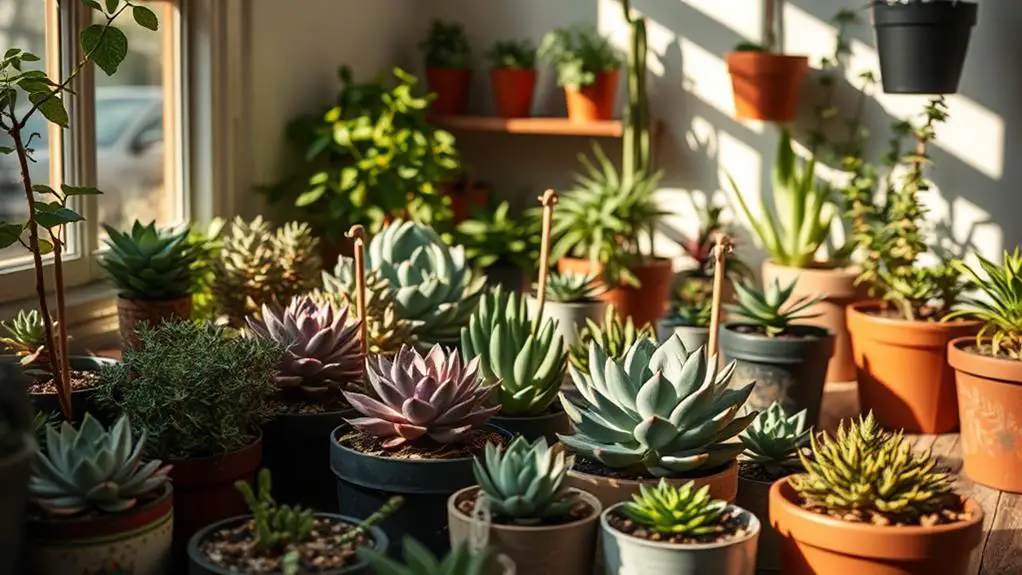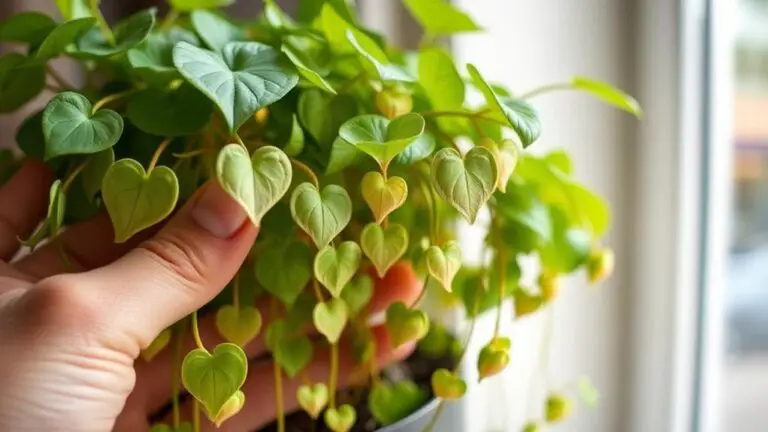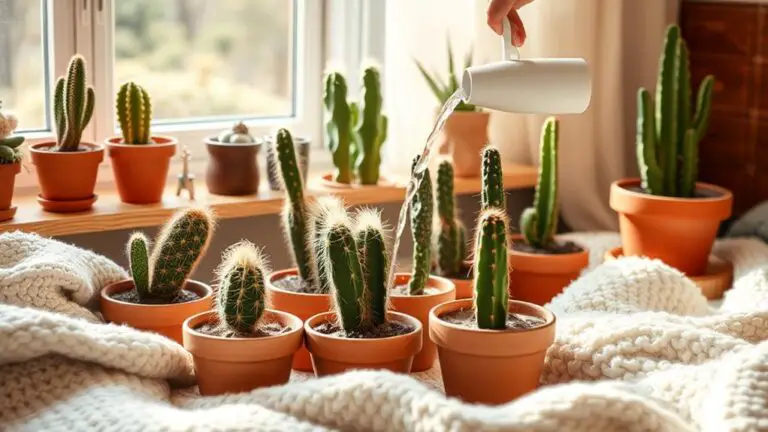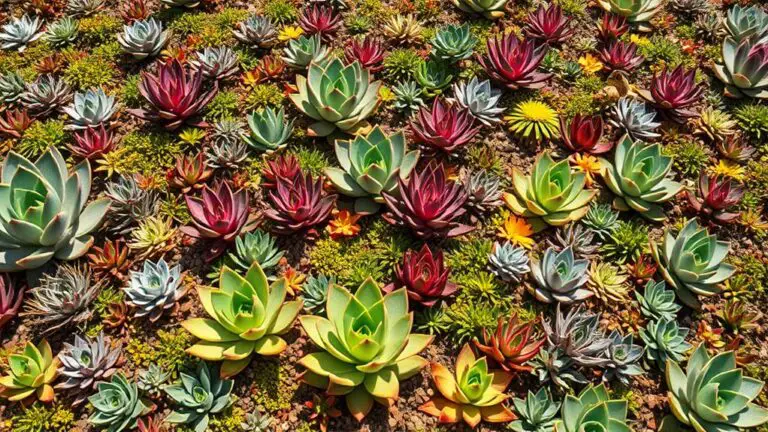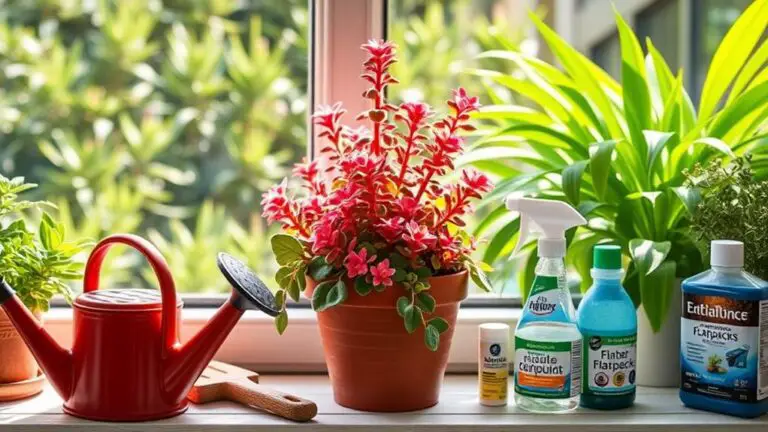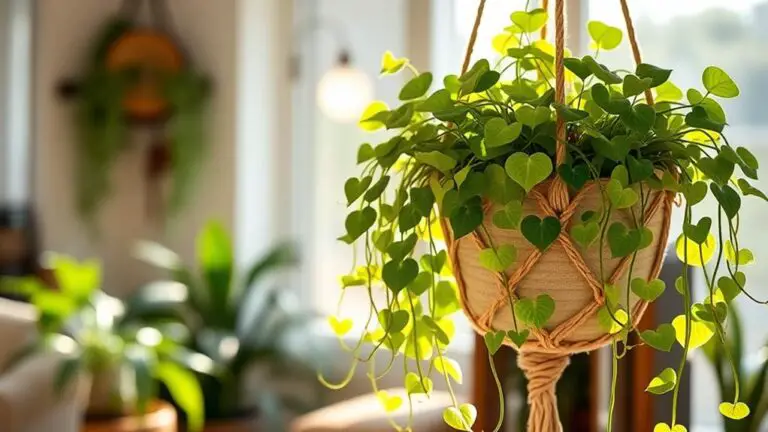10 Tips for Growing Succulents in Low Light
When it comes to growing succulents in low light, you might think it's a challenge, but with the right approach, it's entirely possible. Start by choosing varieties that thrive in such conditions, like Snake Plant and Aloe Vera. It's essential to use well-draining soil and pots with drainage holes to avoid root rot. You'll also need to water sparingly and make sure the soil dries out completely between waterings. Curious about how to keep your succulents healthy and vibrant in less-than-ideal lighting? Let's explore practical tips that can make all the difference.
Choose Low-Light Tolerant Varieties

When growing succulents in low-light conditions, it's important to choose varieties that can thrive with minimal sunlight. One excellent option is the Snake Plant (Dracaena trifasciata). It thrives in low light, needs minimal watering, and adapts well to various light conditions. This makes it perfect for low-light areas in your home.
Another great choice is the Zebra Plant (Haworthiopsis attenuata). This type of Haworthia can handle low light and doesn't need much water. It stays small, usually under 12 inches tall, making it ideal for tight spaces.
Consider the Christmas Cactus (Schlumbergera) too. It tolerates shade and blooms beautifully during the holiday season, adding a festive touch to your home.
If you're looking for versatility, Aloe Vera (Aloe barbadensis) is a good pick. It can thrive in low light but prefers bright, indirect light. This means you have flexibility in where you place it.
These low light succulents are all great options that can help your indoor garden flourish, even in less-than-ideal lighting conditions. By choosing the right plants, you'll guarantee your succulents stay healthy and vibrant.
Use Well-Draining Soil
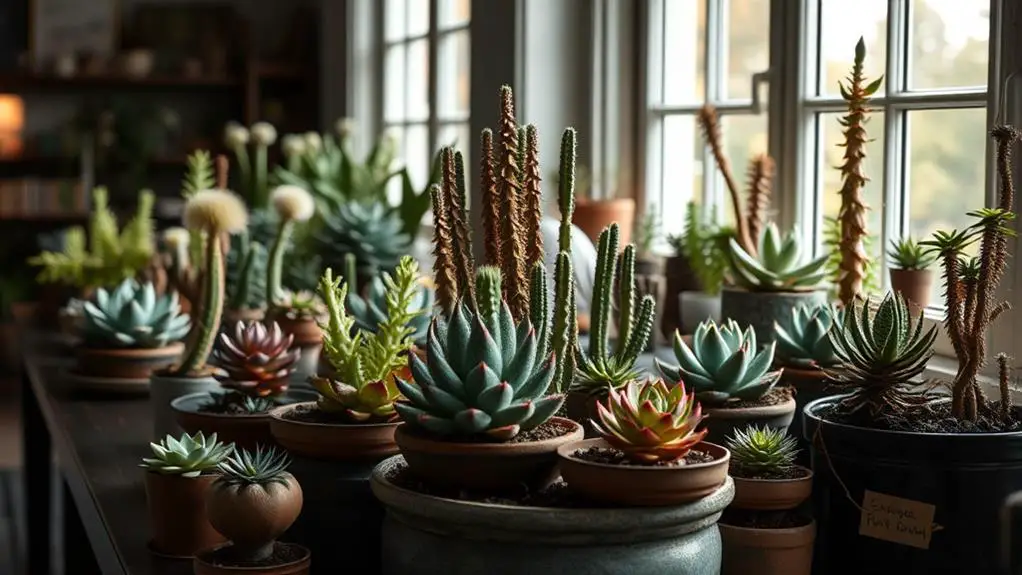
Guaranteeing proper drainage is critical for the health and importance of your succulents.
Using well-draining soil is essential to prevent root rot, which can occur if the soil is too compact or moisture-retaining. A good mix for succulents includes cactus soil, perlite, and sand. This combination guarantees the soil drains quickly, which is ideal for succulents, especially in low light conditions.
To help you get started, follow these steps:
- Mix your soil: Combine cactus soil, perlite, and sand in equal parts. This creates a mix that drains quickly and provides enough aeration for the roots.
- Choose the right pot: Use pots with drainage holes. These holes allow excess water to escape, reducing the risk of root rot.
- Check drainage regularly: Make sure the soil drains quickly. If you notice water pooling on the surface, it means the drainage is poor and needs improvement.
- Add amendments: Consider adding pumice or coarse gravel to your mix. These amendments enhance the soil's drainage properties, keeping your succulents healthy.
Water Sparingly
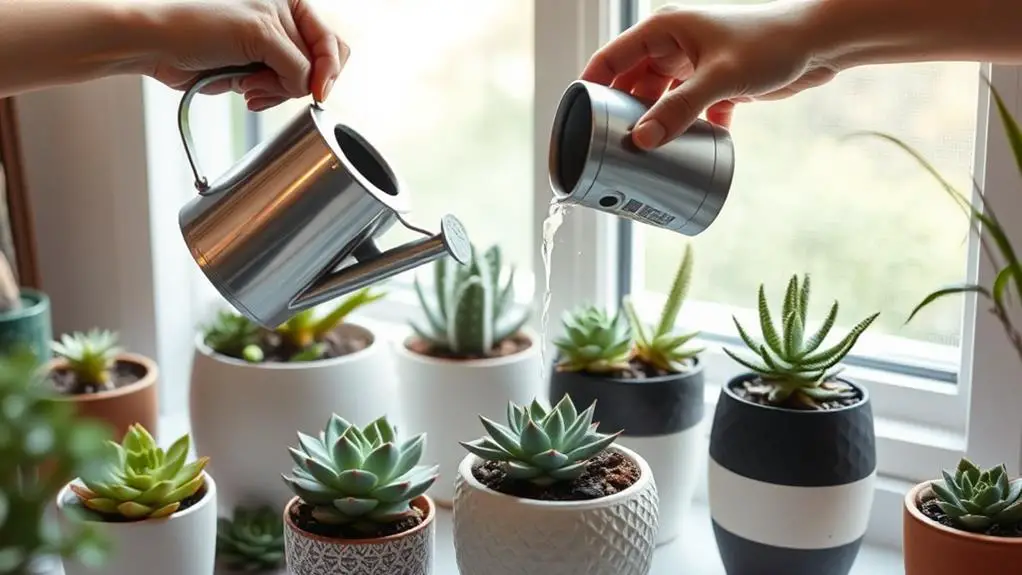
One key aspect of maintaining low light succulents is watering them sparingly. Since succulents need less water in low light conditions, you should let the soil dry out completely between waterings. Overwatering is a common mistake, leading to root rot and other issues.
To keep your succulents healthy, check the soil moisture by inserting your finger about an inch deep. If it feels dry, it's time to water. If it's still moist, wait a bit longer. Typically, watering every two to three weeks is sufficient, but this can vary with the humidity and temperature in your home. During winter, when succulents enter dormancy, reduce watering frequency even further.
Always use well-draining soil to help control moisture and prevent water from accumulating around the roots. This kind of soil guarantees that the roots don't stay wet for too long, which is essential for succulents.
Here's a quick reference table to make it easier:
| Condition | Frequency | Tip |
|---|---|---|
| Normal | 2-3 weeks | Check soil moisture before watering |
| High Humidity | Less frequently | Monitor soil more closely |
| Low Humidity | More frequently | May need slightly more water |
| Winter Dormancy | Every 4-6 weeks | Reduce watering considerably |
Rotate Plants Regularly
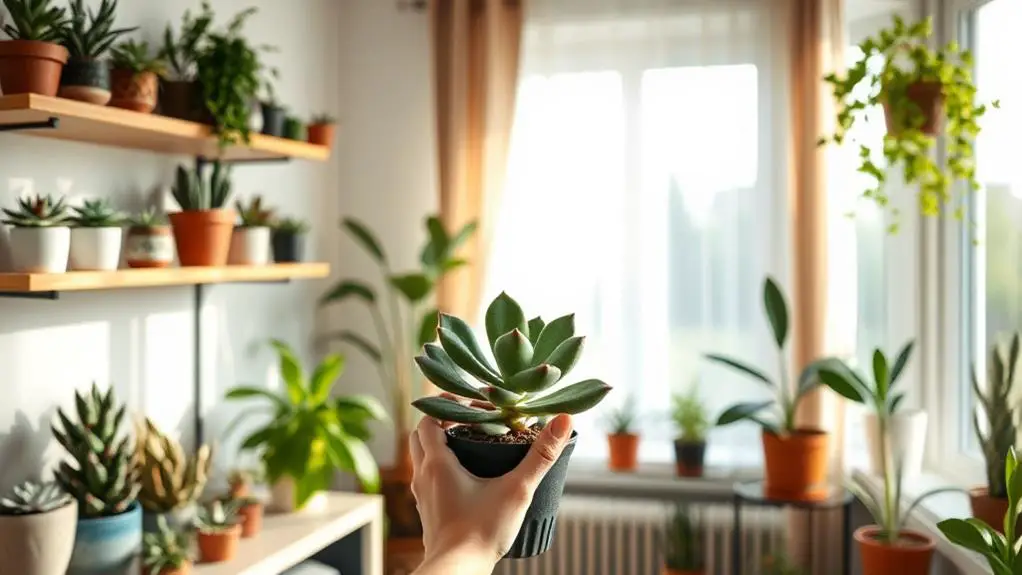
To keep your succulents growing evenly and looking their best, make certain you rotate them every 1-2 weeks.
This simple step helps all sides of the plant get equal light, preventing one side from stretching towards the window and becoming leggy.
Ensure Even Growth
Achieving balanced growth in your succulents can often be a challenge, especially in low-light conditions. One essential practice is to rotate your plants regularly. By turning your succulents 90 degrees every couple of weeks, you guarantee that all sides receive equal light. This promotes even growth and helps prevent legginess, where the plants stretch towards the light source.
Here's a simple routine to follow for even growth:
- Rotate 90 Degrees: Every two weeks, turn your succulents a quarter turn. This guarantees each side gets an equal amount of light.
- Monitor Growth: Use these rotations as an opportunity to check your plants. Look for signs of stress or insufficient light, which can affect their health.
- Maintain Shape: Regular turning helps your plants maintain a compact shape, preventing them from becoming uneven or lopsided.
- Enhance Appearance: By guaranteeing even light exposure, your succulents will have a more balanced and aesthetically pleasing look.
In low-light conditions, succulents may grow more slowly, but consistent rotation can enhance their overall health and appearance.
Establishing this routine not only guarantees balanced growth but also keeps your plants looking their best.
Prevent Uneven Light
Preventing uneven light exposure is vital for the healthy growth of your succulents, especially in low-light environments. To achieve balanced growth, you should rotate your plants regularly. By rotating them every few weeks, you guarantee that all sides receive equal exposure to the available light, which helps prevent uneven growth and leggy appearances.
A simple way to do this is by giving your succulents a 90-degree turn. This exposes different angles of the plant to the light source, counteracting their natural tendency to lean towards it. Consistent rotation not only promotes even growth but also enhances the overall look of your succulents, making them fuller and more symmetrical.
Keeping track of which direction your plants are facing is essential. If you notice one side growing faster, it's a sign that rotation is needed to guarantee even growth.
In low light conditions, this practice is especially important, as your succulents may struggle to grow uniformly without your help.
With a little attention and a consistent rotation schedule, you can prevent uneven light exposure and enjoy beautiful, well-balanced succulents. Don't worry—these steps are simple and make a big difference in your plant's health and appearance.
Utilize Grow Lights
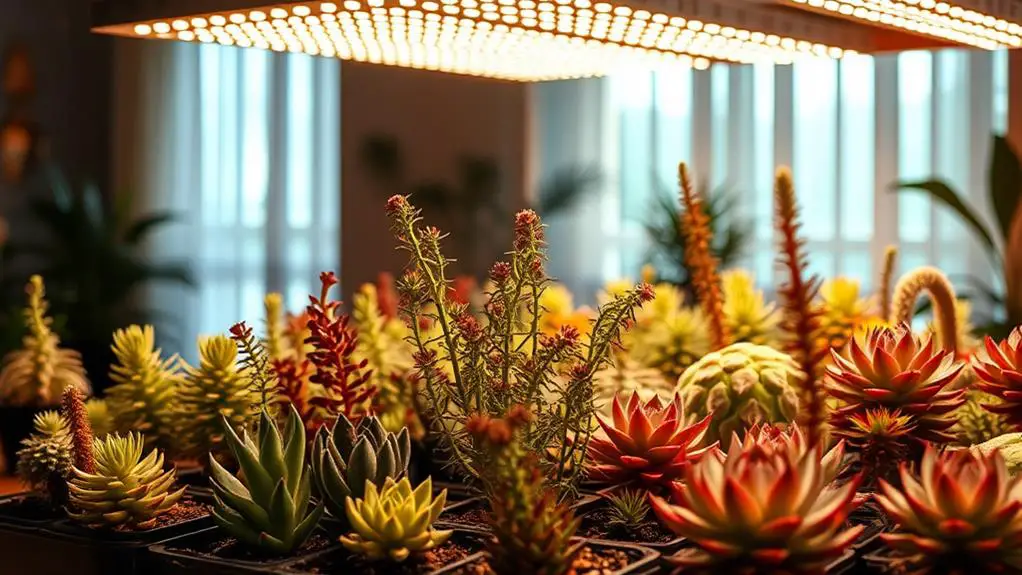
Using grow lights can really help your succulents thrive in low light conditions.
Choose bulbs that provide at least 2,000 lumens per square foot and have a color temperature of around 5,000 Kelvins, as this mimics natural sunlight.
Position the lights 6 to 8 inches above your plants and aim for 14 hours of light each day to keep your succulents happy and healthy.
Benefits of Grow Lights
Grow lights offer several key benefits for growing succulents in low-light environments. They provide essential light wavelengths for photosynthesis, allowing your succulents to thrive even in dim indoor spaces. Here's how grow lights can help:
1. Adequate Light: Full-spectrum grow lights mimic natural sunlight, giving your succulents the energy they need.
With a color temperature starting around 5,000 Kelvins, these lights guarantee your plants get the right kind of light for healthy growth.
2. Consistent Light Cycles: Succulents need about 14 hours of light per day to grow well.
Grow lights provide consistent light cycles, which can accelerate growth and prevent your plants from becoming leggy, especially during seasons with less natural light.
3. Controlled Placement: Hanging grow lights 6 to 8 inches above your succulents ensures they get enough light without overheating.
This placement helps all parts of the plant receive adequate light, promoting uniform growth.
4. Optimal Light Intensity: A minimum of 2,000 lumens per square foot is recommended for succulent growth.
This guarantees your plants get enough light energy to thrive, even in a low-light environment.
Choosing Appropriate Bulbs
When selecting the right bulbs for your grow lights, it's vital to focus on both light intensity and spectrum to guarantee your succulents flourish.
You need adequate light levels to keep your plants healthy. Aim for a minimum of 2,000 lumens per square foot. This guarantees your succulents get the light they need for proper growth.
Full-spectrum lights are a great choice, especially those starting at around 5,000 Kelvins. These lights mimic natural sunlight, which is essential for photosynthesis.
Another excellent option is High Output (HO) T5 bulbs. These bulbs distribute light effectively and emit low heat, helping to prevent overheating and damage to your succulents.
Positioning is also key. Place your grow lights about 6 to 8 inches above the plant canopy. This distance helps avoid burning the leaves.
Make sure to adjust the height based on the heat your bulbs emit.
Lastly, consider using timers. Setting a consistent 14-hour light cycle each day can greatly enhance the growth and development of your succulents, especially in low-light environments.
Avoid Overwatering
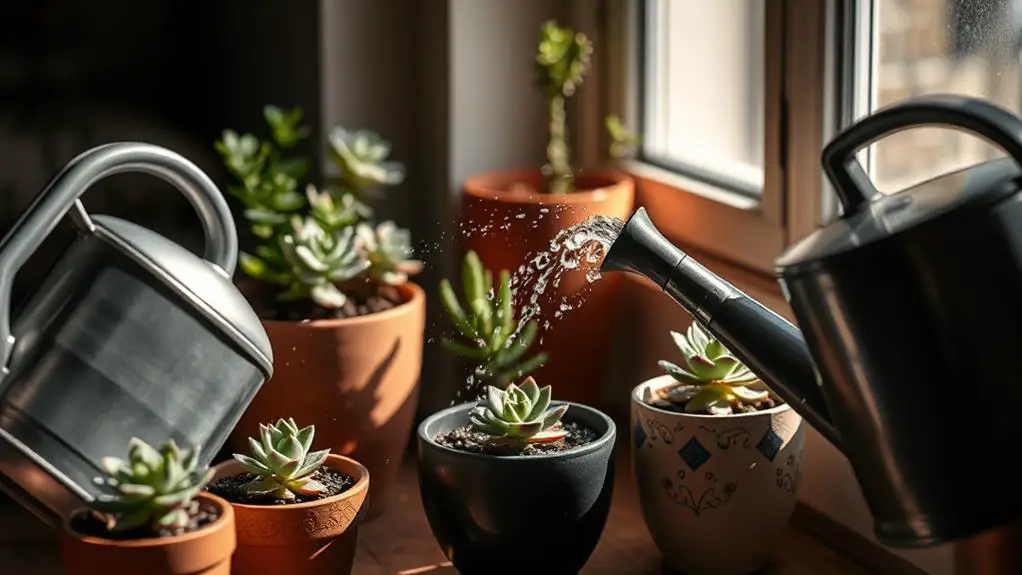
One of the biggest challenges in growing succulents in low light is avoiding overwatering. When light levels are reduced, succulents slow down their growth and water uptake, so it's essential to let the soil dry completely between waterings.
To help you succeed, remember these important tips:
- Check Soil Moisture: Always check the top 1-2 inches of soil for dryness before watering. Succulents thrive in well-draining soil that allows excess moisture to escape.
- Water Less in Winter: During winter or dormancy periods, succulents need even less water. Watering every 2-3 weeks is often sufficient to prevent root rot.
- Use Pots with Drainage Holes: Using pots with drainage holes helps excess water escape, reducing the risk of overwatering and promoting healthier roots.
- Watch for Signs of Overwatering: Be on the lookout for yellowing leaves and mushy stems. These are signs that your succulent is getting too much water and needs immediate adjustments to its watering schedule.
Monitor for Stress Signs
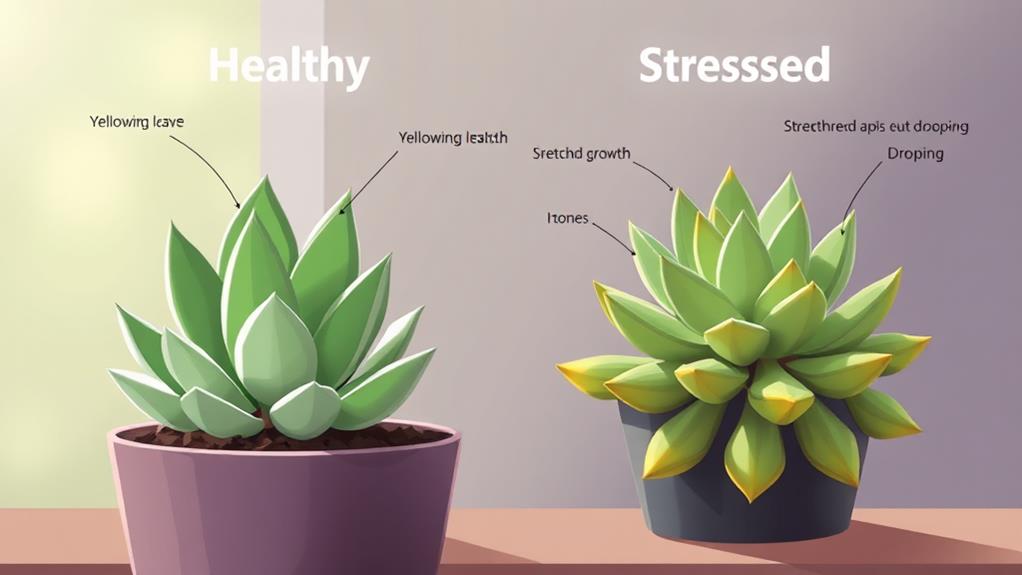
Keep an eye out for leggy growth, as this means your succulent is stretching towards a light source and needs more light.
Watch for any changes in leaf color; dark green leaves are usually fine, but if they lose their vibrant hue, your plant might need more light.
Signs of Legginess
Legginess in succulents is a clear sign that your plant isn't getting enough light. When succulents start stretching towards the nearest light source, they develop elongated stems and spaced-out leaves, losing their compact and healthy appearance. This not only affects their aesthetic appeal but also indicates that your plant is under stress.
To help you spot legginess, look for these signs:
- Elongated Stems: Your succulent's stems grow longer and thinner than usual.
- Spaced-Out Leaves: The leaves are further apart from each other instead of being tightly packed.
- Leaning Plants: The succulent may lean towards the light source, seeking more exposure.
- Weakened Structure: The overall plant structure becomes weaker and less stable.
If you notice these signs, it's time to take action. Move your succulent to a brighter area or use grow lights to provide additional light. This helps prevent further stress and encourages healthier growth.
Regularly monitoring your plant for signs of legginess guarantees it stays vibrant and strong. Don't worry; with a little attention and the right light, your succulent can thrive even in low-light conditions.
Leaf Color Changes
Addressing legginess is just one aspect of ensuring your succulents thrive in low light. Another key factor is monitoring for leaf color changes, as these can indicate stress. In low light conditions, your succulents might develop darker green leaves. This is a positive sign, showing they're adapting to maximize photosynthesis.
However, if you notice the leaves turning yellow or pale, it suggests insufficient light. This can stress your plant, potentially leading to poor health.
Watch out for legginess, where the plant stretches towards light, becoming tall and thin. This is another clear sign of insufficient light. To help, try relocating your succulent to a brighter spot or consider using supplemental lighting. Additionally, if the leaves become more translucent, it could indicate overwatering or low light exposure.
Regularly monitoring your plant's leaf color and texture is vital. These changes provide early warnings of stress, allowing you to make timely adjustments. If you spot any of these signs, act quickly. Move the plant to a better-lit area or adjust your watering habits.
Prune and Propagate
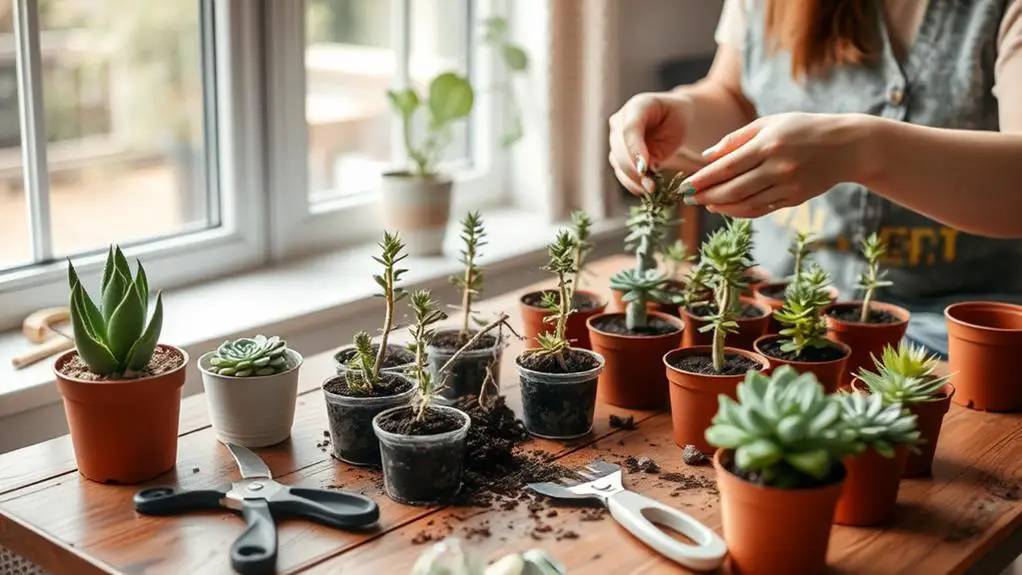
Pruning and propagating succulents are significant tasks, especially when you're dealing with low light conditions. Pruning helps remove leggy growth caused by insufficient light, giving your plants a more compact and appealing shape. To do this, cut just above a leaf node. This not only promotes new growth but also prevents damage to the plant.
Once you've pruned your succulents, you can propagate them using the cuttings. Allow the cut ends to callous over for a few days. This step is essential before planting them in well-draining soil, helping prevent rot. Many succulents, like Jade Plants and Echeverias, root easily from leaf cuttings, so you can expand your collection with ease.
Here are four simple steps to guide you:
- Prune: Trim leggy growth just above a leaf node to encourage compact growth.
- Prepare Cuttings: Let the cut ends callous over for a few days.
- Plant: Place the calloused cuttings in well-draining soil.
- Care: Water sparingly until new roots develop.
Regular pruning rejuvenates your succulents and helps manage their size and health. This is especially important in low light, where growth may be slower.
With these tips, you'll keep your succulents healthy and thriving.
Optimize Placement Near Windows
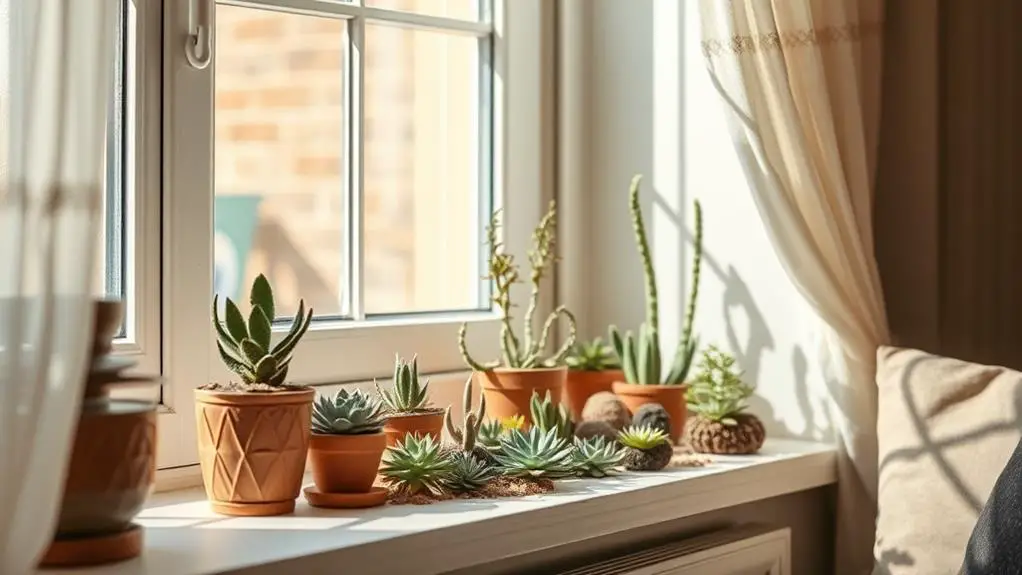
When growing succulents indoors, optimizing their placement near windows is essential for guaranteeing they receive enough light. You want to place your succulents near east-facing windows, where they can soak up indirect morning sunlight. This provides them with about 3 to 4 hours of light each day, promoting healthy growth.
Avoid placing your succulents near north-facing windows, as they usually offer minimal light. Succulents need more light to thrive, and north-facing windows just don't cut it.
If you have south or west-facing windows, use sheer curtains. These will filter out the harsh afternoon sunlight while still allowing enough light to reach your succulents.
Another handy tip is to rotate your pots every few weeks. This guarantees that all sides of your plants get equal exposure to light, preventing them from growing leggy.
Additionally, you can use mirrors or reflective surfaces around your succulents. This helps to bounce light towards them, brightening up low-light spots in your home.
Maintain Humidity Levels
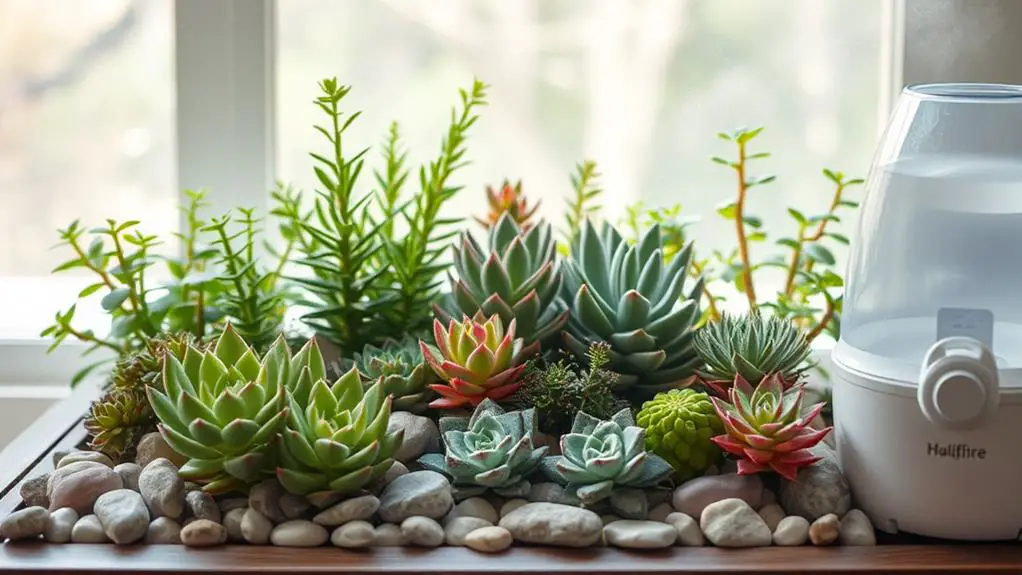
Keeping succulents healthy in low light environments involves more than just adjusting their placement; maintaining proper humidity levels is crucial too. Succulents can suffer in dry air, and guaranteeing they get the right amount of moisture is key to their growth.
To help your succulents thrive, aim for humidity levels between 30% and 50%. Here are some practical steps you can take:
- Use a humidity tray: Place a tray filled with water near your succulents. As the water evaporates, it adds moisture to the air around your plants.
- Group your succulents: By clustering them together, you create a microclimate. The plants will release moisture through transpiration, boosting local humidity levels.
- Misting: Lightly mist your succulents with water from a spray bottle. This can temporarily increase the humidity around them. Just be careful not to overdo it, as too much moisture can lead to rot.
- Invest in a small humidifier: A small humidifier can maintain consistent humidity levels, especially in dry indoor conditions.
Regularly check the humidity with a hygrometer to guarantee it stays in the ideal range. By following these steps, you'll help your succulents flourish even in low light conditions.
Frequently Asked Questions
How Do You Keep Succulents Alive in Low Light?
To keep succulents alive in low light, water them only when the soil's dry. Choose low-light varieties like Snake Plant. Place them near east-facing windows and rotate pots often. Use grow lights for extra help.
What Succulents Can Handle Low Light?
You can grow Snake Plant, ZZ Plant, Haworthia, Christmas Cactus, and Panda Plant in low light. They're all hardy, require minimal watering, and adapt well to less sunlight, making them perfect for dim indoor spaces.
How Often Do You Water Low Light Succulents?
You should water low light succulents infrequently. Let the soil dry out completely between waterings, typically every 2 to 4 weeks. In winter, reduce this to every 3 to 6 weeks. Always check soil moisture first.
Can Succulents Survive in an Office Without Windows?
Yes, succulents can survive in an office without windows. Use artificial grow lights and monitor soil moisture carefully. Rotate the plants periodically for even growth. Some varieties, like ZZ Plant and Snake Plant, adapt well to low light.
Conclusion
With these tips, you're all set to grow succulents in low light like a pro! Choose the right plants, use well-draining soil, and don't forget to water sparingly. Rotate your plants, use grow lights if needed, and keep an eye on their health. Prune and propagate to keep them thriving. Remember, you can do this! With a little care and attention, your succulents will flourish even in low light. Happy gardening!

